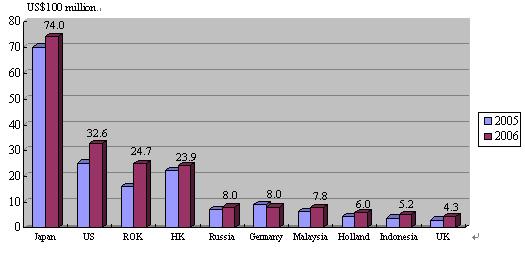| The White Paper on the Quality and Safety of Food in China | |
|---|---|
| Sep 16, 2007 03:10 | |
 | 2. The Quality and Safety of Agricultural Products Is Steadily Improving (1) Fast Growth of High-quality and Safe Brands Quality agricultural products are steadily expanding their market. Agricultural standardization has been notably enhanced, which increases farmers' income and changes their farming patterns. Hazard-free, green and organic products make up 90 percent of all agricultural-product exports. Over the past five years, the export of green food has shot up 40 percent annually, and has been accepted by over 40 of China's trading partners. So far, China has developed 28,600 kinds of hazard-free agricultural products, and set up 24,600 hazard-free production bases with a total area of 21.07 million hectares. Five thousand three hundred and fifteen Chinese enterprises use the green food logo on their 14,339 kinds of products totaling 72 million tons and grown on 10 million hectares of land. In addition, 600 producers use the organic food logo on their 2,647 kinds of products totaling 19.56 million tons and grown on 3.11 million hectares of land. Altogether, there are 539 state-level agricultural demonstration zones, 100 demonstration counties (farms) and nearly 3,500 provincial-level demonstration zones, with a combined growing area exceeding 33.33 million hectares. (2) Acceptance Rate of Agricultural Products Rising Continuously Inspections in the first half of 2007 showed that the average acceptance rate regarding pesticide residues in vegetables was 93.6 percent; those regarding clenbuterol hydrochloride contamination and sulfa drug residues in livestock products was 98.8 percent and 99.0 percent respectively; and that regarding chloromycetin in aquatic products was 99.6 percent, of nitrofuran 91.4 percent, and of pesticide residue over 95 percent in sample surveys done at production bases. |
| Sep 16, 2007 03:11 | |
 | 3. The Quality of Imported and Exported Foodstuffs Stays High China is a large importer and exporter of foodstuffs, with the amount of each growing steadily in recent years. The import and export volume in 2006 totaled US$40.448 billion-worth (excluding wheat, corn and soybean, same below), up 21.45 percent year on year. (See Table 4) Table 4 China's food import and export volumes in 2005 and 2006  |
| Sep 16, 2007 03:14 | |
 | 1) Safety of Export Food Guaranteed In 2006, China exported 24.173 million tons of food, worth US$26.659 billion, up 13.29 percent and 16.0 percent year on year, respectively. The top ten varieties in terms of export value were aquatic products, processed aquatic products, vegetables, canned food, juices and drinks, processed grain products, seasonings, poultry products, alcoholic beverages, and livestock meat and chopped entrails. (See Table 5) Table 5 Top ten food varieties in terms of export value in 2006 as compared with 2005  |
| Sep 16, 2007 03:16 | |
 | Foodstuffs of the mainland of China have been exported to more than 200 countries and regions, of which the top ten in terms of trade volume are Japan, the US, the ROK, Hong Kong, Russia, Germany, Malaysia, Holland, Indonesia and the UK. (See Table 6) Table 6 Top ten countries and region in terms of China's export value of food in 2006 as compared with 2005  |
| Sep 16, 2007 03:18 | |
 | For many years, over 99 percent of China's exported foodstuffs have been up to standard. In 2006 and the first half of 2007, China exported to the US some 94,000 batches and 55,000 batches of foodstuffs, respectively, and 752 batches and 477 batches of each were found by the US to be substandard, making the acceptance rate 99.2 percent and 99.1 percent, respectively. In the case of the EU, the figures were 91,000 batches and 62,000 batches, with 91 batches and 135 batches found by the EU to be substandard, making the acceptance rate 99.9 percent and 99.8 percent, respectively. On July 20, 2007, the Ministry of Health, Labor and Welfare of Japan, the largest importer of Chinese food, released an examination report on food imported from China in 2006, which showed that Japan conducted more sample surveys on Chinese food (15.7 percent) than on food from anywhere else, but Chinese food had the highest acceptance rate (99.42 percent), followed by that imported from the EU (99.38 percent) and the US (98.69 percent). The mainland of China is a major supplier of food for the Hong Kong Special Administrative Region. Two large food sample surveys conducted by Hong Kong's Food and Environmental Hygiene Department in the first half of 2007 showed that the acceptance rate stood at 99.2 percent and 99.6 percent, respectively. |
| Sep 16, 2007 03:21 | |
 | 2) Quality of Imported Food Stable In 2006, China imported 20.273 million tons of food, worth US$13.396 billion, up 37.94 percent and 25.11 percent year on year, respectively. The top ten varieties in terms of import value were vegetable oil, aquatic products, cereals, sugar, dairy products, alcoholic beverages, tobacco and associated products, poultry and chopped entrails, oil crops, and processed grain products. (See Table 7) Table 7 Top ten food varieties in terms of import value in 2006 as compared with 2005  |
| Sep 16, 2007 03:23 | |
 | China imports foodstuffs from 143 countries and regions, and the top ten in terms of trade value are Malaysia, Russia, the US, Indonesia, Argentina, Thailand, Australia, New Zealand, Brazil and France. (See Table 8) Table 8 Top ten countries in terms of China's import value of food in 2006 as compared with 2005  |
| Sep 16, 2007 03:25 | |
 | For many years, the quality of food China imports has been fairly stable, and no serious hazard has been caused by imported food. During the period from 2004 to the first half of 2007, the acceptance rate of imported food, according to statistics released by the ports of entry, were 99.29 percent (2004), 99.46 percent (2005), 99.11 percent (2006) and 99.29 percent (first half of 2007), respectively. |
| Sep 16, 2007 03:45 | |
 | Dreamlife, thank you for a very detailed report. It made interesting reading. Dodger. |
| Sep 16, 2007 04:42 | |
 | On my opinion, talking about quality of food is basicly talking about markets. Years behind "made in China" ment low quality. About 20 years ago I myself was very surprized with my new jogging shoes. I supposed finnish jogging shoes were made in Finland as before, but these were made in China. Well, after few hard trains they broke. Nowadays finnish jogging shoes are made in Korea, Philippines, China and so on because of lower employment costs. Also finnish clothing industry is dead in Finland because of same reason. Can talk about electric industry, too, Nokia first of all. Shoes are, as well as clothes and mobile phones are quite high quality nowadays. More and more goods come from cheap product cost countries, including food. About a year ago, a whole factory making mobile phones parts was closed in Finland and moved to China. 1200 people lost their jobs. Western countries are worried about their own production and employmet situation. I think protectionism is natural reaction against cheap products from abroad. This morning in finnish tv was said that changing rice from dinner table to finnish potatoes is an act for environment protection. True, but in my opinion quite meaningless. I only think all weapons in protectionism are in use. I have been to China twice. Both times I have eaten only chinese food, sometimes in places finnish health officials would burn immediately. Not once have been problems. Compared to Spain, Turkiye and Tunis, where I have had sometimes very serious illnesses because of food, I was very surprized I got absolutely nothing in China. Talk about quality of food is necessary, I think. Then talking about health of population, too. But if used as a weapon of protectionism, it is only used as an attempt to ensure maximum profit to global companies. |
Post a Reply to: The White Paper on the Quality and Safety of Food in China







 Copyright © 1998-2026 All rights reserved.
Copyright © 1998-2026 All rights reserved.